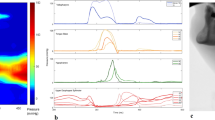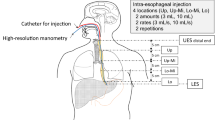Abstract
Swallowing has hitherto been evaluated during physical examination, radiologic barium studies, manometry, and cervical auscultation. Radiography principally demonstrates qualitative aspects of oral and pharyngeal function, whereas quantitative aspects have primarily been documented by manometry. To evaluate swallowing quantitatively, without using invasive methods or radiation, we have applied a combined test of water drinking, i.e., the Repetitive Oral Suction Swallow test (ROSS). The test provides reliable measurements of suction pressure, bolus volume, timing of important events in oral and pharyngeal swallow, and respiration. The test is described and results from 292 healthy, nondysphagic subjects are presented. We found a mean bolus volume of 25.6±8.5 ml during single swallow and 21.1±8.2 ml during stress (forced, repetitive swallow). During forced, repetitive swallow, the bolus volume was more strongly associated with suction time (r2=0.55) than with peak suction pressure (r2=0.04), indicating that suction time is more important than suction pressure in determining the bolus volume. The oral-pharyngeal transit time decreased: single swallow 0.56±0.36 sec, forced repetitive swallow 0.23±0.11 sec, as did the coefficient of variation (48% and 64%, respectively) indicating a more automatic neural process for pharyngeal function in forced, repetitive swallow. The postswallow respiration started with inspiration in 10% of studied individuals, but did not correlate with deviations in other variables in the test. Thus, postswallow inspiration must be considered as normal. The ROSS test offers a rapid and easy quantitative assessment of swallowing.
Similar content being viewed by others
References
Cook IJ, Dodds WJ, Dantas RO, Kern MK, Massey BT, Shaker R, Hogan WJ: Timing of videofluoroscopic, manometric events, and bolus transit during oral and pharyngeal phases of swallowing. Dysphagia 4:8–15, 1989
Sonies BC, Parent LJ, Morrish K, Baum BJ: Durational aspects of the oral-pharyngeal phase of swallow in normal adults. Dysphagia 3:1–10, 1988
Curtis DJ, Cruess DF, Dachman AH: Normal erect swallowing. Normal function an incidence of variations. Invest Radiol 20:717–726, 1985
Selley WG, Flack FC, Ellis RE, Brooks WA: The Exeter dysphagia assessment technique. Dysphagia 4:227–235, 1990
Nicklin J, Karni Y, Wiles CM: Measurement of swallowing time—a proposed method. Clin Rehabil 4:335–336, 1990
Nathadwarawala KM, Nicklin J, Wiles CM: A timed test of swallowing capacity for neurological patients. J Neurol, Neurosurg, Psychiatry 55:822–825, 1992
Selley WG, Flack FC, Ellis RE, Brooks WA: Respiration patterns associated with swallowing: part 2. Neurologically impaired dysphagic patients. Age Ageing 18:173–176, 1989
Parrott LC, Selley WG, Brooks WA, Lethbridge PC, Cole JJ, Flack FC, Ellis RE, Tripp JH: Dysphagia in cerebral palsy: a comparative study of the Exeter dysphagia assessment technique and a multidisciplinary assessment. Dysphagia 7:209–219, 1992
Nilsson H, Ekberg O, Hindfelt B: Oral function test for monitoring suction and swallowing in the neurologic patient. Dysphagia 10:93–100, 1995
Bosma JF: Pharyngeal swallow: basic mechanisms, development, and impairment. Adv Otolaryngol Head Neck Surg 6:225–275, 1992
Palmer JB, Rudin NJ, Lara G, Crompton AW: Coordination of mastication and swallowing. Dysphagia 7:187–200, 1992
Dodds WJ, Stewart ET, Logemann JA: Physiology and radiology of the normal oral and pharyngeal phases of swallowing. AJR 154:953–963, 1990
Castell JA, Dalton CB, Castell DO: Pharyngeal and upper esophageal sphincter manometry in humans. Am J Physiol 258:G173–178, 1990
Miller AJ: Deglutition. Physiol Rev 62:129–184, 1982
Wolff PH: The serial organization of sucking in the young infant. Pediatrics 42:943–956, 1968
Selley WG, Ellis RE, Flack FC, Brooks WA: Coordination of sucking, swallowing and breathing in the newborn: its relationship to infant feeding and normal development. Br J Disord Commun 25:311–327, 1990
Bu'Lock F, Woolridge MW, Baum JD: Development of coordination of sucking, swallowing and breathing: ultrasound study of term and preterm infants. Dev Med Child Neurol 32:669–678, 1990
Jean A: Brainstem organization of the swallowing network. Brain Behav Evol 25:109–116, 1984
Jean A: Control of central swallowing program by inputs from the peripheral receptors. A review. J Auton Nerv Syst 10:225–233, 1984
Buchholz DW, Bosma JF, Donner MW: Adaptation, compensation, and decompensation of the pharyngeal swallow. Gastrointest Radiol 10:235–239, 1985
Adnerhill I, Ekberg O, Groher ME: Determining normal bolus size for thin liquids. Dysphagia 4:1–3, 1989
Spiers RL, Staniforth A, Sittampalam G: Subjective assessment of liquid volumes by humans during swallowing. Arch Oral Biol 33:701–706, 1988
Curtis DJ, Cruess DF, Dachman AH: Normal erect swallowing. Normal function and incidence of variations. Invest Radiol 20:717–726, 1985
DePippo KKL, Holas MA, Reding MJ: Validation of the 3-oz swallow test for aspiration following stroke. Arch Neurol 49:1259–1261, 1992
Selley WG, Flack FC, Ellis RE, Brooks WA: Respiration patterns associated with swallowing: part 1. The normal adult pattern and changes with age. Age Ageing 18:168–172, 1989
Ren J, Shaker R, Zamir Z, Dodds WJ, Hogan WJ, Hoffmann RG: Effect of age and bolus variables on the coordination of the glottis and upper esophageal sphincter during swallowing. Am J Gastoenterol 88:665–669, 1993
Watson WA, Bradford DC, Veltri JC: The volume of a swallow. Correlations of deglutition with patient and container parameter. Am J Emerg Med 1:278–281, 1983
Tracy JF, Logemann JA, Kahrilas PJ, Jacob P, Kobara M, Krugler C: Preliminary observations of the effects of age on oropharyngeal deglutition. Dysphagia 4:90–94, 1989
Ekberg O, Feinberg MJ: Altered swallowing function in elderly patients without dysphagia: radiological findings in 56 cases. AJR 156:1181–1184, 1991
Author information
Authors and Affiliations
Rights and permissions
About this article
Cite this article
Nilsson, H., Ekberg, O., Olsson, R. et al. Quantitative assessment of swallowing in healthy adults. Dysphagia 11, 110–116 (1996). https://doi.org/10.1007/BF00417900
Issue Date:
DOI: https://doi.org/10.1007/BF00417900




